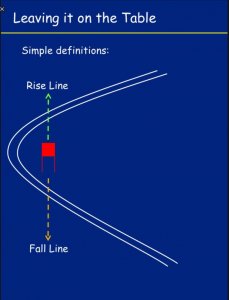"Complete your turns" is another one of those phrases that isn't self-explanatory and may have different meanings to different people.
Racers I believe may or may not want to be continuously carving. Sometimes a very rounded line is fastest. Sometimes it's faster to go more directly at gates and turn tightly around them. That could entail straight line drifts between turns. Those line choices are reserved for the most skilled racers, I would think. I'll have to leave it to others to expound on this.
At the lower intermediate level, many skiers have a pattern of making turns that are too shallow for speed control on the slopes they're on, and compensate by using braking movements for speed control. These are skiers who could benefit from "completing their turns" in the sense of just letting the arcs go on longer, of going farther across the hill with each turn. I think this is commonly a reflection of weak basic turn mechanics, of an inability to manage the forces that build as a turn continues. On the other hand, many skiers could do better than they imagine, and forcing themselves to make turns that go on longer may bring out improved movements. This is where simple "follow the leader" practice can bring big returns. Once skiers start repeating the necessary moves, they get better at them, even without further coaching.
A more subtle form of the "complete your turns" advice addresses the issues of skiers who are trying mightily to follow a good, rounded, rhythmic line, but whose grip on the snow deteriorates in the final phase of the turn. This often displays as a rotation of the body in the direction of the turn in that last part of the turn, a leaning to the inside, and a fairly abrupt divergence of the skis and development of a big tip lead in that phase. The skier might even be quite good at bringing the feet close together in the initiation phase, yet they drift apart at the end. This results from an effort to engage a moderately-weighted inside ski, and failure to balance over the inside edge of the outside ski, so that the outside ski breaks away. The deficiencies in the finishing phase of the turn stem from a lack of commitment to balancing on and moving with the outside ski earlier in the turn. Instead of riding out the turn on that one ski, the skier is hedging by using the inside ski in counterproductive fashion. As forces build, the outside ski can't hang on. This is seen not only in carved turns, but also in slipped or brushed turns. In the latter case, the skier isn't riding one edge of the outside ski, yet the commitment to that ski and the lateral displacement of that ski need to be smooth and continuous throughout a turn. The basic mechanics of a good turn remain the same.
A skier unable to maintain grip in the last part of a turn loses the momentum that would allow for an effective release, a cross-under movement, and a smooth movement of the body mass toward the inside of the new turn. So the skier is left with little choice but to slow down deliberately at the end of the turn, giving up momentum across the slope in favor of gravity which will start the body toppling down the hill, and supplementing this with a push off the new outside ski.
For such skiers, it's necessary to work on building the strength of the commitment to the outside ski, and the placement of body mass where it can fully engage that ski in the ongoing turn and be ready to move quickly toward the inside of the next turn. Exercises could include one-footed big toe edge traverses; garlands in which the skier practices an uphill carve to a slow speed, followed by a release until the skis point nearly downhill, followed by another uphill carve; downhill hand-to-boot touches; and one-footed outside ski turns. It may also be necessary to strengthen the tension of the muscles in the foot and ankle, and the ability to create and hold a bit of knee angulation, so as to counteract the tendency of building forces to want to roll a ski off edge. "Completing a turn" for these skiers will mean completing the finishing phase with grip and consistent turning action of the skis.

